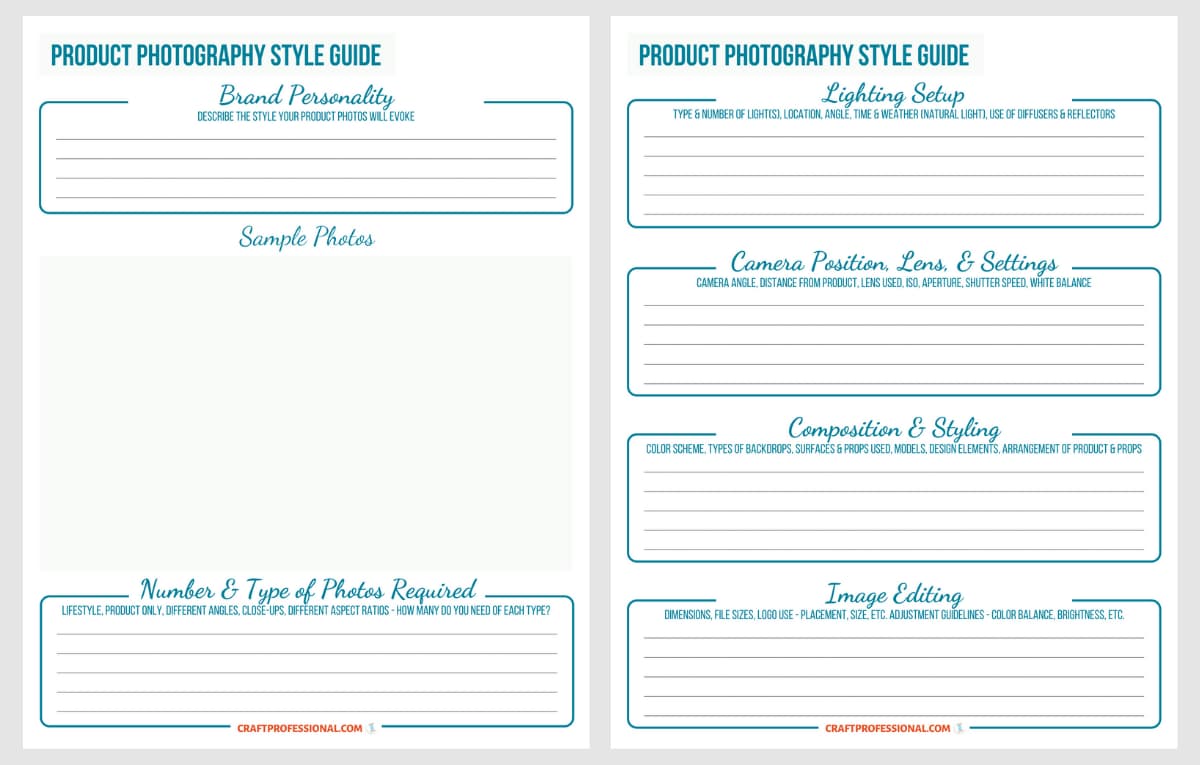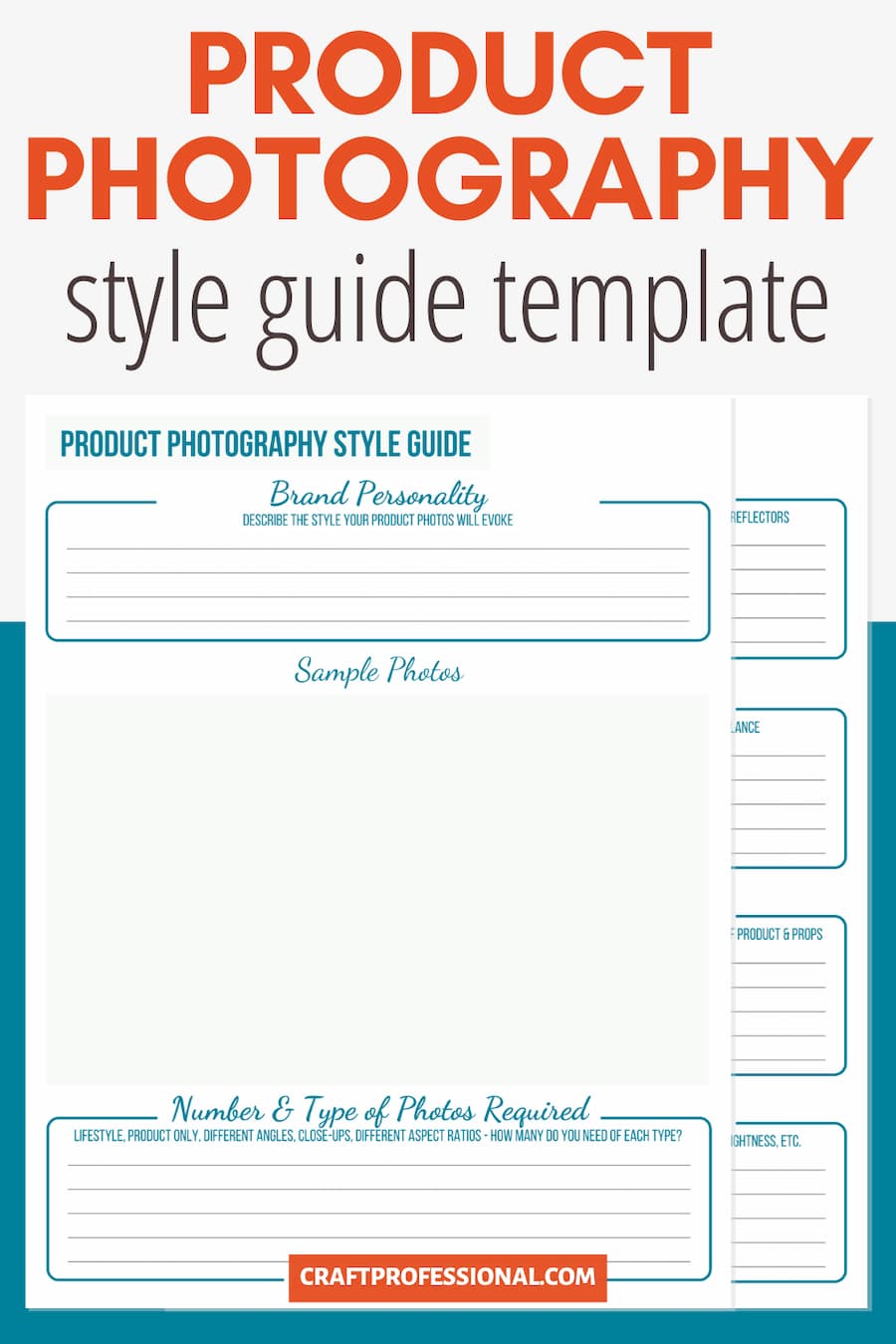- Home
- Craft Photography
- Product Photography Style Guide
Product Photography Style Guide & PDF Template
Develop a photography style guide, and download a free PDF template, so you can create consistent product photos for your brand.
A product photography guide is a written set of rules or guidelines you follow each time you photograph your items.
Your guide can describe any number of elements you want to keep consistent throughout your brand imagery, such as:
- the direction and angle of the light source
- the distance and angle between the camera and the product
- the number and types of photos you take of each product
- colors allowed for backdrops and props that are used
Why should you create a photography style guide?
As you experiment with craft photography, certain looks you love will emerge in your collection of product photos.
You'll want to be able to reproduce those looks.
A written style guide will tell you exactly how to set up your camera, lighting, products, backdrops, and props, so you can reliably and efficiently capture the look you want any time, over several photo sessions.
Images for each product don't have to be exactly the same. A photography style guide will help you create a set of images that have elements in common, so they form a cohesive set.
Benefits of using brand imagery guidelines to create product photos with a consistent visual style:
Clear Messaging
A consistent look for all of your product photos unifies your brand. It helps you communicate a clear story about your products that resonates with target customers.
Increased Perceived Value
When several product photos viewed together create a cohesive looking collection — in your Etsy shop, for example — you raise the perceived value of your products. Raising the perceived value of your products can enable you to increase your prices.
Reliable Results
If you create a written guide detailing all of the elements that go into creating photos for your products, you'll be able to reproduce a consistent look whenever you need to photograph new products.
Efficiency
Clear guidelines describing your product photography setup will enable you to prepare for photo sessions faster, eliminate guesswork, and work more efficiently.
Communicate and Delegate
A written product photography style guide will make it easy to communicate what you need if, at some point, you want to switch from DIY product photography and hire a professional.
How do you create a photography style guide?
1. Develop your Brand's Visual style
Of course, before you can create a style guide, you'll need to develop your style.
This process can take time and experimentation. However, you can speed things up by systematically analyzing many product photography ideas to find styles that will work for your brand.
2. Determine Your Product Image Needs
Think about how you will use your product photos. This information will help you determine the number and types of images you'll need.
Ask yourself questions such as:
- How many photos will you need to show your products from all angles?
- Do you want to use lifestyle photos or product photography on a simple white background?
- Where will you use your images, and how will that impact the size and composition of the photos you need?
As you think through your image needs, write it all down.
3. Take Notes as You Photograph Your Crafts
As you experiment with product photography, take notes to document different setups you use.
Information about the lens and camera settings you used (such as aperture value, shutter speed, ISO, and white balance) for each photo are stored in the image file. If you need to go back and check the settings you used for a particular photo, you can see all of that when you view your images on your computer.
You'll need additional information to recreate a particular look such as:
- the distance between the product and camera
- the angle of the camera
- the time of day, weather conditions and location if you're using natural light in your photography
That information is not recorded by your camera, so you'll need to take notes. You can download a product photography style guide PDF template at the bottom of this page to help you keep track of things.
What should go in a photography style guide?
Your photography style guide should include all of the information you need to create a consistent look for all of your product images.
It will tell you exactly how to set up for your photo sessions, allowing you to work more efficiently and helping beginner photographers take great photos more reliably.
Here are some of the details you can document in your brand imagery guide.
Brand Personality
List some words and phrases that describe the personality or image you want to create for your brand. This character should be reflected in your product photos.
If you haven't thought about your brand's personality, take a look at my guidelines for writing a business naming brief. The guidelines focus on naming your business, but they will help you think through the process of defining your brand in a way that will appeal to target customers.
Number and Types of Photos Required
- lifestyle photos
- product only images on a plain background
- all angles you need to show of your product
- product detail closeups
- other elements, such as product packaging
- photo sizes and compositions required for different uses - you may need to compose images differently for Instagram or your Etsy shop (square images) vs. Pinterest (tall rectangular images)
Camera Position
- distance between the camera and the product
- angle of camera
Consider using a tripod in your product photography.
A tripod will allow you to maintain consistent camera positions and angles far better than you could if you photograph your products using a handheld camera.
Camera Settings & Lens Used
- lens used
- focal length (if you use a zoom lens)
- ISO
- aperture value
- shutter speed
- white balance setting
Lighting Setup
If you use artificial light:
- type of lights you use
- number of lights
- distance from each light to the product
- angles of each light
- anything in the environment that impacts the light
If you use natural light:
- time of day
- weather conditions
- location
- time of year (the quality of natural light can change throughout different seasons)
- anything in the environment that impacts the light (such as large surfaces that may reflect color)
If you use diffusers:
- type of diffusers
- placement of the diffusers
If you use reflectors:
- type of reflector(s) used
- color of reflectors used
- distance of reflectors relative to light source and product
- angle of reflectors
Composition and Styling
- colors you do and do not use in brand images
- type and color(s) of backdrops used
- type and color(s) of surfaces used
- distance from the product to the backdrop
- models - do you use models, and what character or style do you want the appearance of your models to reflect
- arrangement of products and props
- use of design elements such as line, texture, shape
Postproduction / Image Editing
Set up a template that you use each time you edit product photos. A template, along with a set of rules directing how you edit product photos will help you work more efficiently and maintain consistency with factors such as:
- dimensions for cropping photos
- file sizes required
- guidelines for adjusting color balance, brightness, etc.
- do you add a logo on some or all images
- rules for logo placement, size and alteration
Sample Images
Include some sample photos of your products that represent the look you want to achieve across all of your brand images. Referring back to those samples will help you refocus on your desired look and remain consistent throughout photo sessions.
Photography Style Guide Template
You can keep track of all of your brand photography guidelines with this printable PDF. Click the button below to download.




New! Comments
Have your say about what you just read! Leave me a comment in the box below.